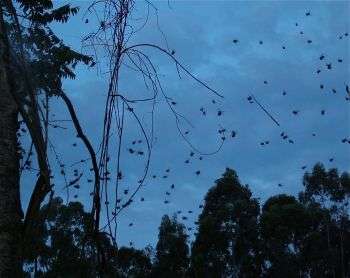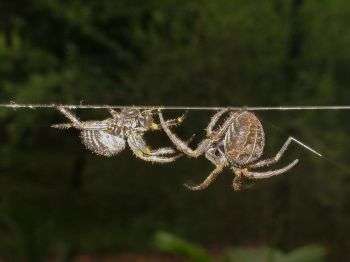Study reveals strategy behind spiders' web etiquette

(Phys.org) —A species of spider that, unusually, lives in a colony but hunts alone at night is the subject of a new study by an international team of scientists including University of Sussex biologists.
Spiders are normally ferocious lone hunters and trappers of prey – even prospective mates can end up as dinner for some species.
But in the case of the colonial orb-web spider Parawixia bistriata, individual survival is best served by co-operating and even tolerating a little bit of freeloading behaviour from colony-mates.
The researchers' observations are published in the July edition of the journal The American Naturalist.
Sussex academics Professor Jonathan Bacon, Professor Francis Ratnieks and Dr Margaret Couvillon took part in the field study in southern Brazil alongside scientists from the University of York and from Belgium, Brazil and Poland.
During the day the spiders (each about 4cm across including the legs) doze quietly together in a bivouac, a soccer-ball-sized huddle of hundreds of spiders in a bush or tree. The bivouac sits at the centre of a network of permanent thick silk lines which radiate out to adjacent trees and bushes.
Things change dramatically at sunset. The spiders move out along the silk lines and build many adjacent orb webs, one per spider, each anchored to several of the permanent silk lines. Before daybreak, each spider consumes its own web and returns, along the permanent silk lines, to the safety of the bivouac.
Early in the evening, when there is still plenty of web-building space, a spider already building its web or sitting in the centre of a recently-completed web bounce up and down at any spider walking on one of the nearby anchoring lines. Invariably, the intruder moves off, looking for a vacant space of its own within the network of permanent silk lines.

However, things change once all the potential web-building sites become occupied. Bouncing is now rare as most or all of the spiders have a web. But if there are a lot of spiders, some may not find a vacant space. These webless spiders now ignore a resident's bounces and sit patiently at the web perimeter; they are occasionally rewarded by sneaking in to share a large insect prey with the resident.
Professor Bacon says: "Charles Darwin almost certainly observed this species while travelling overland in Argentina in October 1832, describing them in his Voyage of the Beagle as 'many large black spiders, with ruby-coloured marks on their backs, having gregarious habits'.
"Darwin went on to remark that 'this gregarious habit, in so typical a genus as Epeira, among insects, which are so bloodthirsty and solitary that even the two sexes attack each other, is a very singular fact."
Almost two centuries later, says Professor Bacon, scientists now understand that the spiders' behavioural strategies keep the peace and prevent these dangerous well-armed carnivores from getting into costly confrontations with their neighbours. "One night's food is not worth risking death for," says Professor Bacon.
Professor Ratnieks says: "This switch in the behavioral strategy of the webless spiders makes perfect sense. Early in the evening all spiders respect the resident's ownership because there is a high chance of finding another web-building site. Later on, when there is little chance of finding a web-building site, it is better to ignore the bouncing and hang around an existing web rather than search. But they never fight; this is simply too dangerous."
More information: Wenseleers, T. and Bacon, J. Bourgeois behavior and freeloading in the colonial orb-web spider Parawixia bistriata (Araneae, Araneidae), The American Naturalist, no. 182. www.jstor.org/stable/full/10.1086/670525
Journal information: American Naturalist
Provided by University of Sussex





















